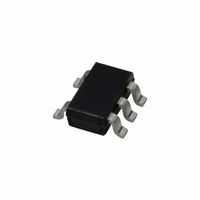LMV7251M5 National Semiconductor, LMV7251M5 Datasheet - Page 7

LMV7251M5
Manufacturer Part Number
LMV7251M5
Description
IC COMPARATOR 1.8V LO V SOT23-5
Manufacturer
National Semiconductor
Type
General Purposer
Datasheet
1.LMV7251M5.pdf
(11 pages)
Specifications of LMV7251M5
Number Of Elements
1
Output Type
CMOS, Push-Pull, Rail-to-Rail
Voltage - Supply
1.8 V ~ 5 V, ±0.9 V ~ 2.5 V
Mounting Type
Surface Mount
Package / Case
SC-74A, SOT-753
Lead Free Status / RoHS Status
Contains lead / RoHS non-compliant
Other names
LMV7251M5TR
Available stocks
Company
Part Number
Manufacturer
Quantity
Price
Part Number:
LMV7251M5
Manufacturer:
NS/国半
Quantity:
20 000
Application Info
Basic Comparators
A comparator is quite often used to convert an analog signal
to a digital signal. The comparator compares an input volt-
age (V
(V
(V
output voltage (V
Hysteresis
The basic comparator configuration may oscillate or produce
a noisy output if the applied differential input is near the
comparator’s input offset voltage. This tends to occur when
the voltage on the input is equal or very close to the other
input voltage. Adding hysteresis can prevent this problem.
Hysteresis creates two switching thresholds (one for the
rising input voltage and the other for the falling input volt-
age). Hysteresis is the voltage difference between the two
switching thresholds. When both inputs are nearly equal,
REF
O
) is low (V
) at the inverting pin. If V
IN
) at the non-inverting pin to the reference voltage
OL
FIGURE 2. Basic Comparator
). However, if V
O
) is high (V
Input/Output
LMV7251
LMV7255
OH
IN
IN
is less than V
).
is greater than V
DS200057-15
DS200057-16
REF
DS200057-17
the output
REF
, the
7
hysteresis causes one input to effectively move quickly pass
the other. Thus, effectively moving the input out of region that
oscillation may occur.
Hysteresis can easily be added to a comparator in a
non-inverting configuration with two resistors and positive
feedback Figure 3 . The output will switch from low to high
when V
The output will switch from high to low when V
where V
The Hysteresis is the difference between V
R2) - V
For an inverting configured comparator, hysteresis can be
added with a three resistor network and positive feedback.
When input voltage (V
non-inverting node (V
circuit for the three resistor network is R1 in parallel with R3
and in series with R2. The lower threshold voltage V
calculated by:
When V
equivalent circuit for the three resistor network is R2 in
parallel with R3 and in series with R1. The upper threshold
voltage V
V
R3))
The hysteresis is defined as
(V
FIGURE 3. Non-Inverting Comparator Configuration —
V
V
T2
CC
IN
IN
= V
= V
= V
((R2 R3) / (R2 + R3)) / ((R1 + ((R2 R3) / (R2 + R3)))
V
V
V
CC
IN
IN
IN1
IN2
T1
CC
IN2
T1
IN1
T2
rises up to V
R1) / R2) = V
is greater than V
= ((V
((R2 R3) / (R2 + R3)) / ((R1 + ((R2 R3) / (R2 +
- V
= (V
is calculated by
= (V
- V
is calculated by:
T2
IN2
REF
REF
CC
= ((V
= ((V
R2) / ((R1 R3) / (R1+ R3)) + R2)
(R1 + R2))/ R2
(R1 + R2) - V
T
CC
IN
IN1
), the output is high. The equivalent
REF
CC
) at the inverting node is less than
LMV7251
R2) / ((R1 R3) / (R1+ R3)) + R2) –
, where V
T
R1/ R2.
(R1 + R2)) / R2) - ((V
, the output voltage is low. The
CC
IN1
R1) / R2
is calculated by
IN1
DS200057-19
IN
and V
falls to V
DS200057-18
www.national.com
REF
IN2
(R1 +
T1
.
IN2
is
,











